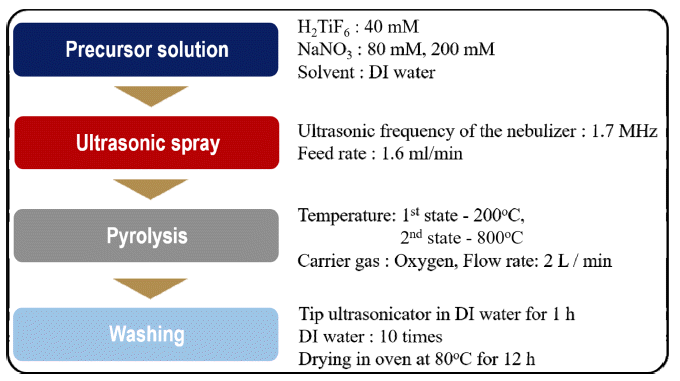Search
- Page Path
- HOME > Search
- [Korean]
- Effect of Pyrolysis temperature on TiO2 Nanoparticles Synthesized by a Salt-assisted Ultrasonic Spray Pyrolysis Process
- Jae-Hyun Yoo, Myeong-Jun Ji, Woo-Young Park, Young-In Lee
- J Korean Powder Metall Inst. 2019;26(3):237-242. Published online June 1, 2019
- DOI: https://doi.org/10.4150/KPMI.2019.26.3.237

- 513 View
- 3 Download
-
 Abstract
Abstract
 PDF
PDF In this study, ultrasonic spray pyrolysis combined with salt-assisted decomposition, a process that adds sodium nitrate (NaNO3) into a titanium precursor solution, is used to synthesize nanosized titanium dioxide (TiO2) particles. The added NaNO3 prevents the agglomeration of the primary nanoparticles in the pyrolysis process. The nanoparticles are obtained after a washing process, removing NaNO3 and NaF from the secondary particles, which consist of the salts and TiO2 nanoparticles. The effects of pyrolysis temperature on the size, crystallographic characteristics, and bandgap energy of the synthesized nanoparticles are systematically investigated. The synthesized TiO2 nanoparticles have a size of approximately 2–10 nm a bandgap energy of 3.1–3.25 eV, depending on the synthetic temperature. These differences in properties affect the photocatalytic activities of the synthesized TiO2 nanoparticles.
- [Korean]
- Synthesis and Optical Property of TiO2 Nanoparticles Using a Salt-assisted Ultrasonic Spray Pyrolysis Process
- Myeong-Jun Ji, Woo-Young Park, Jae-Hyun Yoo, Young-In Lee
- J Korean Powder Metall Inst. 2019;26(1):34-39. Published online February 1, 2019
- DOI: https://doi.org/10.4150/KPMI.2019.26.1.34

- 554 View
- 1 Download
- 1 Citations
-
 Abstract
Abstract
 PDF
PDF Current synthesis processes for titanium dioxide (TiO2) nanoparticles require expensive precursors or templates as well as complex steps and long reaction times. In addition, these processes produce highly agglomerated nanoparticles. In this study, we demonstrate a simple and continuous approach to synthesize TiO2 nanoparticles by a salt-assisted ultrasonic spray pyrolysis method. We also investigate the effect of salt content in a precursor solution on the morphology and size of synthesized products. The synthesized TiO2 nanoparticles are systematically characterized by X-ray diffraction, transmission electron micrograph, and UV-Vis spectroscopy. These nanoparticles appear to have a single anatase phase and a uniform particle-size distribution with an average particle size of approximately 10 nm. By extrapolating the plots of the transformed Kubelka-Munk function versus the absorbed light energy, we determine that the energy band gap of the synthesized TiO2 nanoparticles is 3.25 eV.
-
Citations
Citations to this article as recorded by- Effect of Pyrolysis temperature on TiO2 Nanoparticles Synthesized by a Salt-assisted Ultrasonic Spray Pyrolysis Process
Jae-Hyun Yoo, Myeong-Jun Ji, Woo-Young Park, Young-In Lee
Journal of Korean Powder Metallurgy Institute.2019; 26(3): 237. CrossRef
- Effect of Pyrolysis temperature on TiO2 Nanoparticles Synthesized by a Salt-assisted Ultrasonic Spray Pyrolysis Process
- [Korean]
- Preparation of FeAl nanopowders by Plasma Arc Discharge Process
- Woo-Young Park, Cheol-Su Youn, Ji-Hun Yu, Young-Woo Oh, Chul-Jin Choi
- J Korean Powder Metall Inst. 2004;11(6):522-527.
- DOI: https://doi.org/10.4150/KPMI.2004.11.6.522

- 265 View
- 0 Download
-
 Abstract
Abstract
 PDF
PDF - Nano sized FeAl intermetallic particles were successfully synthesized by plasma arc discharge pro-cess. The synthesized powders shouted core-shell structures with the particle size of 10-20 nm. The core was metallic FeAl and shell was composed of amorphous AI_2O_3;and;a;little;amount;of;metallic;Fe_3O_4. Because of the difference of Fe and Al vapor pressure during synthesis, the Al contents in the nanoparticles depended on the Al contents of master alloy.
- [Korean]
- Characterization of Fe Nanocapsules synthesized by Plasma Arc Discharge Process
- Woo-Young Park, Cheol-Su Youn, Ji-Hun Yu, Young-Woo Oh, Chul-Jin Choi
- J Korean Powder Metall Inst. 2004;11(6):510-514.
- DOI: https://doi.org/10.4150/KPMI.2004.11.6.510

- 300 View
- 0 Download
-
 Abstract
Abstract
 PDF
PDF - Iron-carbon nanocapsules were synthesized by plasma arc discharge (PAD) process under various atmosphere of methane, argon and hydrogen gas. Characterization and surface properties were investigated by means of HRTEM, XRD, XPS and Mossbauer spectroscopy. Fe nanocapsules synthesized were composed of three phases (alpha-Fe,;Y-Fe;and;Fe_3C) with core/shell structures. The surface of nanocapsules was covered by the shell of graphite phase in the thickness of 4~5nm.
TOP
 kpmi
kpmi


 First
First Prev
Prev


